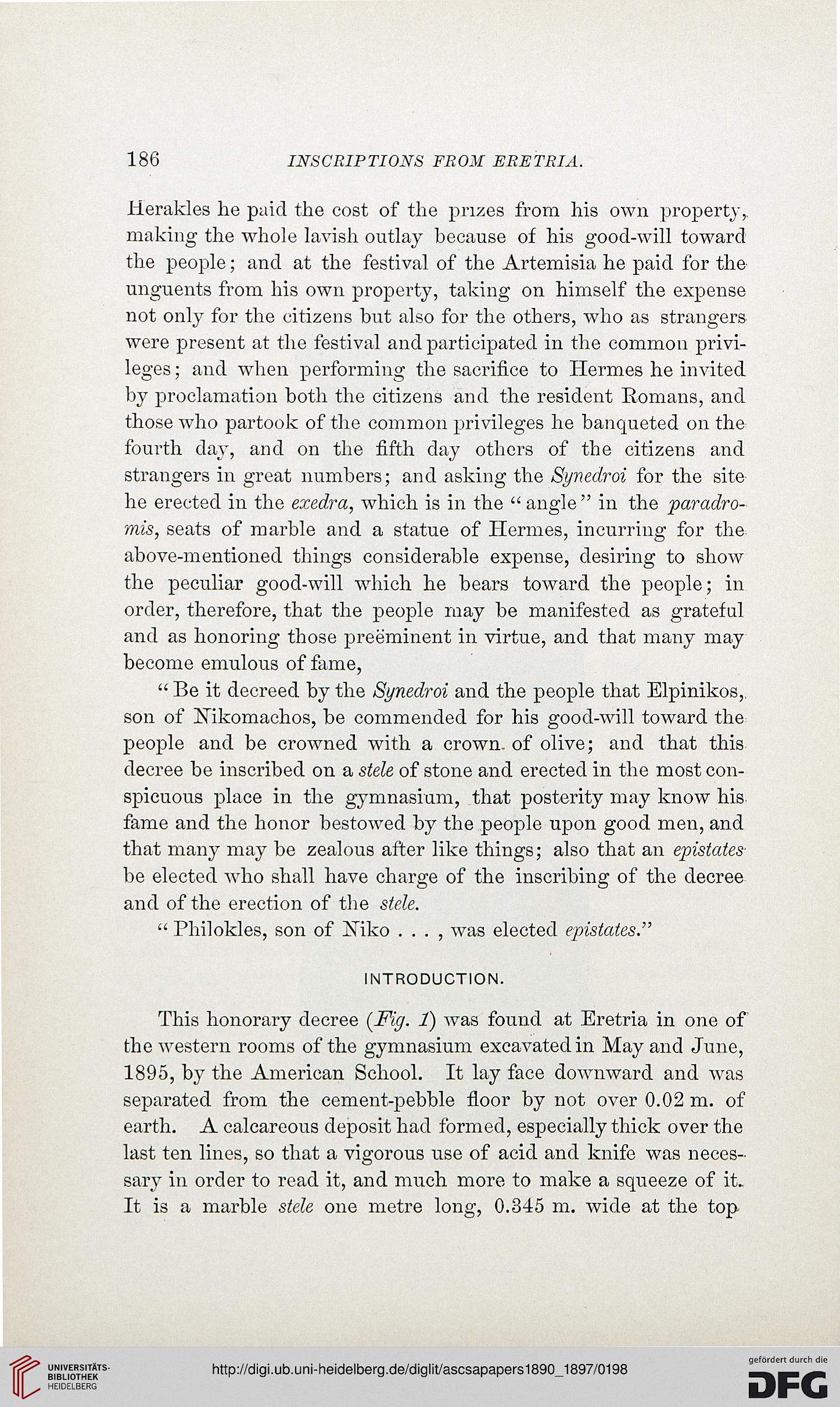186
INSCRIPTIONS FROM ERETRIA.
Herakles he paid the cost of the prizes from his own property,,
making the whole lavish outlay because of his good-will toward
the people; and at the festival of the Artemisia he paid for the
unguents from his own property, taking on himself the expense
not only for the citizens but also for the others, who as strangers
were present at the festival and participated in the common privi-
leges ; and when performing the sacrifice to Hermes he invited
by proclamation both the citizens and the resident Romans, and
those who partook of the common privileges he banqueted on the
fourth day, and on the fifth day others of the citizens and
strangers in great numbers; and asking the Synedroi for the site
he erected in the exedra, which is in the " angle " in the paradro-
mis, seats of marble and a statue of Hermes, incurring for the
above-mentioned things considerable expense, desiring to show
the peculiar good-will which he bears toward the people; in
order, therefore, that the peoj)le may be manifested as grateful
and as honoring those preeminent in virtue, and that many may
become emulous of fame,
" Be it decreed by the Synedroi and the people that Elpinikos,,
son of Nikomachos, be commended for his good-will toward the
people and be crowned with a crown- of olive; and that this
decree be inscribed on a stele of stone and erected in the most con-
spicuous place in the gymnasium, that posterity may know his.
fame and the honor bestowed by the people upon good men, and
that many may be zealous after like things; also that an epistates-
be elected Avho shall have charge of the inscribing of the decree
and of the erection of the stele.
" Philokles, son of Xiko . . . , was elected epistates."
INTRODUCTION.
This honorary decree {Fig. 1) was found at Eretria in one of
the western rooms of the gymnasium excavated in May and June,
1895, by the American School. It lay face downward and was
separated from the cement-pebble floor by not over 0.02 m. of
earth. A calcareous deposit had formed, especially thick over the
last ten lines, so that a vigorous use of acid and knife was neces-
sary in order to read it, and much more to make a squeeze of it.
It is a marble stele one metre long, 0.345 m. wide at the top
INSCRIPTIONS FROM ERETRIA.
Herakles he paid the cost of the prizes from his own property,,
making the whole lavish outlay because of his good-will toward
the people; and at the festival of the Artemisia he paid for the
unguents from his own property, taking on himself the expense
not only for the citizens but also for the others, who as strangers
were present at the festival and participated in the common privi-
leges ; and when performing the sacrifice to Hermes he invited
by proclamation both the citizens and the resident Romans, and
those who partook of the common privileges he banqueted on the
fourth day, and on the fifth day others of the citizens and
strangers in great numbers; and asking the Synedroi for the site
he erected in the exedra, which is in the " angle " in the paradro-
mis, seats of marble and a statue of Hermes, incurring for the
above-mentioned things considerable expense, desiring to show
the peculiar good-will which he bears toward the people; in
order, therefore, that the peoj)le may be manifested as grateful
and as honoring those preeminent in virtue, and that many may
become emulous of fame,
" Be it decreed by the Synedroi and the people that Elpinikos,,
son of Nikomachos, be commended for his good-will toward the
people and be crowned with a crown- of olive; and that this
decree be inscribed on a stele of stone and erected in the most con-
spicuous place in the gymnasium, that posterity may know his.
fame and the honor bestowed by the people upon good men, and
that many may be zealous after like things; also that an epistates-
be elected Avho shall have charge of the inscribing of the decree
and of the erection of the stele.
" Philokles, son of Xiko . . . , was elected epistates."
INTRODUCTION.
This honorary decree {Fig. 1) was found at Eretria in one of
the western rooms of the gymnasium excavated in May and June,
1895, by the American School. It lay face downward and was
separated from the cement-pebble floor by not over 0.02 m. of
earth. A calcareous deposit had formed, especially thick over the
last ten lines, so that a vigorous use of acid and knife was neces-
sary in order to read it, and much more to make a squeeze of it.
It is a marble stele one metre long, 0.345 m. wide at the top




